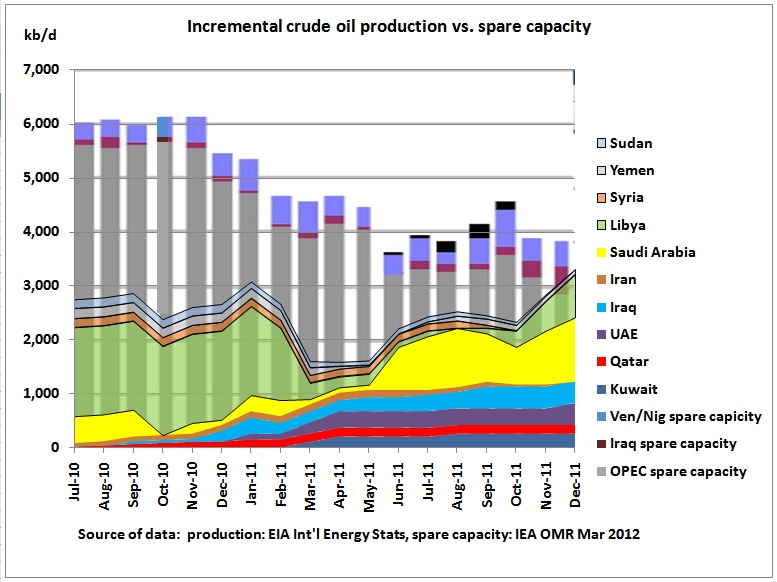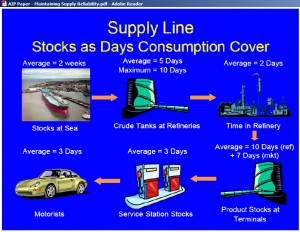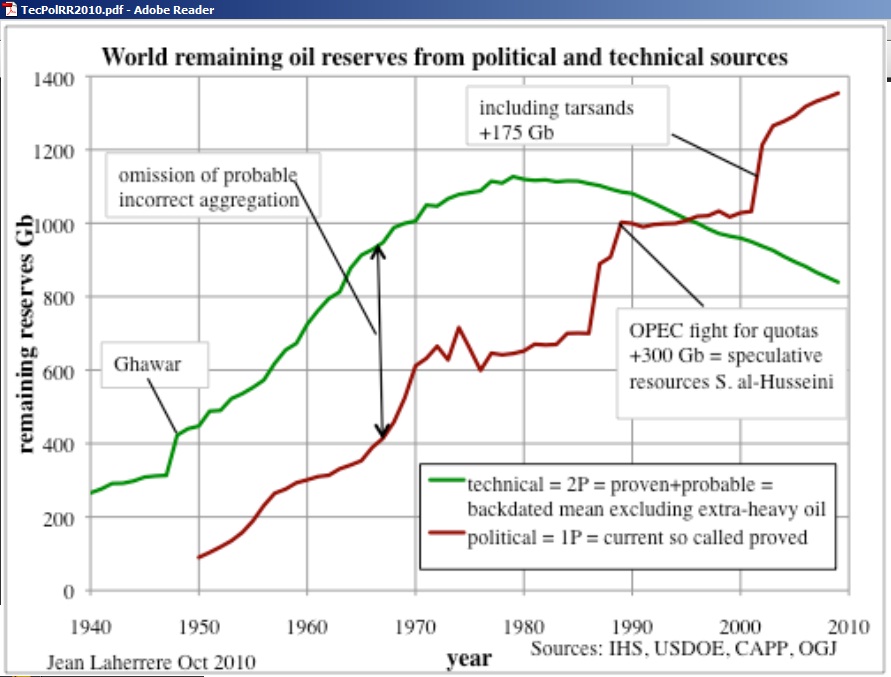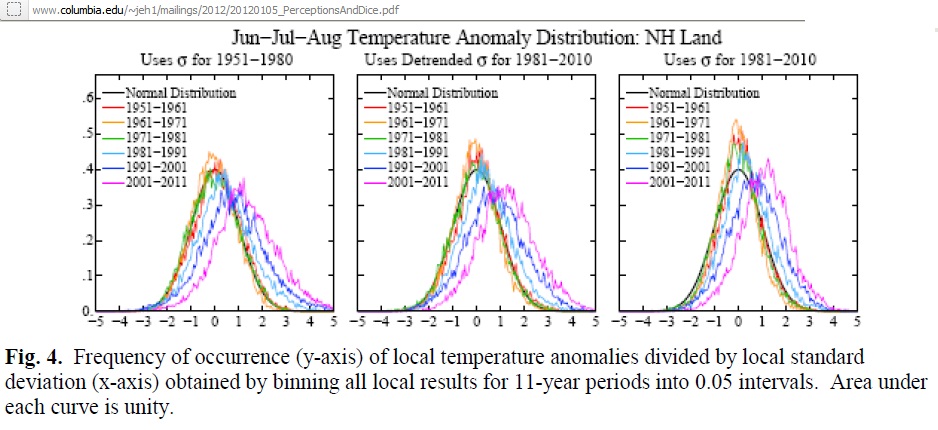First it was Alan Kohler getting his ideas from a Citi bank report on the death of peak oil, now it is Tony Jones accepting advice from peak oil denier Yergin that there is no peak due to unconventional oil. This ignores earlier information given in the ABC TV stories “the incredible journey of oil” in May 2007 and “oil crunch” in April 2011. Not to mention Tony’s own interview with NASA climatologist James Hansen who said we really can’t afford the CO2 from unconventional fossil fuels.
So ABC TV is going backwards. Why?
Contents:
(1) Oil shock and peak oil in Iran
(2) The price of oil – unpredictable
(3) High oil prices damage the economy
(4) Function of the SPR in OECD countries – but what about Australia?
(5) No shortage of oil?
(6) Run out of cheap oil
(7) The myth of US energy sufficiency
(8) The wrong question on oil reserves and production
(9) The Quest for the dirty oil
The link to Tony Jones’ interview is here:
The complexities of energy delivery
29/3/2012
http://www.abc.net.au/lateline/content/2012/s3467044.htm
(1) Oil shock and peak oil in Iran
TONY JONES: Can we start with the immediate energy future? Are we headed for a new global oil shock as tensions rise over Iran’s nuclear program?
Comment: The oil shock is ongoing and has already sparked fuel riots, civil unrest and armed conflicts in many oil producing countries. It can be seen every day on TV. Apparently journalists cannot see the wood for the trees.
 27/3/2012 Just 2 days before the Yergin interview there were street protests in Indonesia against fuel price hikes
27/3/2012 Just 2 days before the Yergin interview there were street protests in Indonesia against fuel price hikes
http://www.nrc.nl/inbeeld/2012/03/27/indonesiers-demonstreren-tegen-hogere-benzineprijs/
DANIEL YERGIN: Certainly, the main reason we’re seeing oil prices rise right now is in anticipation of both the embargo that the Europeans are putting on Iranian oil and also the sanctions the US are putting on the Iranian central bank, all of which – and Iranian threats to close the Strait of Hormuz, their military exercises.
Comment: The embargo comes at a time where Iran is at its 2nd and last oil peak. The 1st Iranian oil peak happened in the mid 70s under the Shah, who overproduced by stacking one giant oil field on top of each other, but could not maintain that high production level of 6 mb/d. Even without the 1979 revolution oil production would have declined but the political changes and the Iran-Iraq war in the 80s made this decline worse. Now, after a long production plateau and another peak, we have quite a similar situation in that the sanctions accelerate the peaking and the decline.
This graph from an October 2009 presentation “National Iranian Oil Company, Strategy and Performance Profile” by PFC Energy shows that the base production started to decline around 2003. New sources compensated for the decline until around 2008 but now the proven, but undeveloped fields (PUDs) don’t come on stream and production started to slide down along the upper edge of “new sources”.
 http://www.riskmanagementmonitor.com/wp-content/uploads/2010/05/Picture-23.png
http://www.riskmanagementmonitor.com/wp-content/uploads/2010/05/Picture-23.png
The green line has been added and is the production from 8 giant oil fields which was in 2010 just 41 % of their peak in 1976 (data kindly provided by Jean Laherrere)
DANIEL YERGIN: So all in all, it’s both a rise in tension over supply and whether there’s going to be enough oil and whether it be replacement barrels and just the general tension itself.
Comment: Let’s have a look at what happened with Saudi oil production when Libyan oil production dropped to zero in 2011:
According to the IEA definition spare capacity must be mobilized within 30 days and held for 90 days. We can see from the graph that there was a considerable delay of several months until Saudi Arabia ramped up production (and it was also a heavier oil than the light Libyan oil). All in all, the Libyan production loss between February and December 2011 was 420 million barrels. But the Saudis pumped only an extra of 220 mb.
How about Middle East OPEC? Wasn’t there a big spare capacity in the wings in 2010/2011?
This graph is from the IEA Monthly Oil Market Report March 2012. Let’s put that into context with actual incremental production as the crisis evolved in Libya, Yemen, Sudan and Syria:
We see that actual increments from ME OPEC were only around 2.5 mb/d by Dec 2011, and the assumed spare capacity of 5 mb/d was not supplied to the market in those critical months. By the end of 2011, production of this group of countries was only slightly higher than in Jan 2011. This does not bode well for how the world will cope with production drops in Iran. Slow and inadequate response to supply disruptions is one characteristic of peak oil.
(2) The price of oil – unpredictable
TONY JONES: Do you have any idea how much the price of a barrel of oil could rise if this actually becomes worse?
DANIEL YERGIN: You know, Tony, so much depends upon the scenario in which it happens. If the Iranians come, as they’re planning to now, come to the negotiating table in April and are serious, we’d see one direction of price, but there are so many scenarios out there, really depending very much on events.
Comment: Yergin has become very cautious with oil price predictions. Too many were wrong in the past. When Yergin’s book came out in September, petroleum geologist Jeff Brown from ASPO USA analysed his oil price predictions:
(i) In November 2004 Yergin predicted that the oil price in November 2005 would be $38 while it turned out to be $58
(ii) In July 2005 Yergin dismissed concerns about Peak Oil and predicted:
Our new, field-by-field analysis of production capacity, led by my colleagues Peter Jackson and Robert Esser, is quite at odds with the current view and leads to a strikingly different conclusion: There will be a large, unprecedented buildup of oil supply in the next few years. Between 2004 and 2010, capacity to produce oil (not actual production) could grow by 16 million barrels a day — from 85 million barrels per day to 101 million barrels a day — a 20 percent increase. Such growth over the next few years would relieve the current pressure on supply and demand.
http://www.washingtonpost.com/wp-dyn/content/article/2005/07/29/AR2005072901672.html
Well, that never happened. Jeff continues:
(iii) Mr. Yergin also implied that there would be plenty of oil supply to meet the increasing demand for oil imports from the Chindia region, presumably without adversely affecting other oil importers. He was half right. Chindia’s combined net oil imports did increase from 5.1 mbpd in 2005 to 7.5 mbpd in 2010 (BP), but it came at considerable cost to other importers.
Jeff Brown’s article can be found here:
http://www.aspousa.org/index.php/2011/10/three-strikes/
 << And that’s what we can see in this graph, US imports fell sharply, by around 3.5 mb/d.
<< And that’s what we can see in this graph, US imports fell sharply, by around 3.5 mb/d.
which I published in my post
18/10/2011 Australia beats them all – in oil imports
http://crudeoilpeak.info/australia-beats-them-all-in-oil-imports
(3) High oil prices damage the economy
TONY JONES: How dangerous is this period? It obviously comes at a difficult time with the United States struggling for economic recovery and Europe as well.
Comment: The word “period” seems to imply that the Iranian problem is temporary. But the era of peaking and then declining oil production is permanent.
DANIEL YERGIN: This is a big problem. This is – some would say this now looms as maybe the largest threat to economic recovery. The Europeans are certainly alarmed by it.
And it’s different – you know, the last time we had these prices go up was 2008. Then it was the beginning of this decline and people didn’t actually see the decline coming. Now we know that it’s been a long struggle to climb out of this recession and to have – if we do have an oil shock, prices even higher than we’re seeing today, that’s certainly not good for recovery.
Comment: We have the convergence of accumulated debt and limited oil supplies both of which are interrelated as described in Gail Tverberg’s article “The link between peak oil and peak debt”
http://ourfiniteworld.com/2011/07/11/the-link-between-peak-oil-and-peak-debt-part-1/
This underlying problem – a kind of pre-condition of the economy – was brought to the surface when Saudi Arabia’s oil production declined in 2006/2007. Everyone seems to have forgotten Matthew Simmons’ 2005 book “Twilight in the desert, the coming Saudi oil shock and the world economy”
James Hamilton in a Brookings Paper titled “Causes and Consequences of the Oil Shock of 2007–08” sums it up:
This paper explores similarities and differences between the run-up of oil prices in 2007-08 and earlier oil price shocks, looking at what caused the price increase and what effects it had on the economy. Whereas historical oil price shocks were primarily caused by physical disruptions of supply, the price run-up of 2007-08 was caused by strong demand confronting stagnating world production. Although the causes were different, the consequences for the economy appear to have been very similar to those observed in earlier episodes, with significant effects on overall consumption spending and purchases of domestic automobiles in particular. In the absence of those declines, it is unlikely that we would have characterized the period 2007:Q4 to 2008:Q3 as one of economic recession for the U.S. The experience of 2007-08 should thus be added to the list of recessions to which oil prices appear to have made a material contribution.
So this was not a normal, cyclical recession, it was triggered by the first years of peak oil.
(4) Function of the SPR in OECD countries – but what about Australia?
TONY JONES: Not good for a president in an election year either. But I’m wondering with the Strategic Petroleum Reserve that was created obviously to cushion the US economy from these kind of oil shocks, will it work? Will it be used?
DANIEL YERGIN: Well, the Strategic Petroleum Reserve is of course part of a larger system of stocks that are held by the other countries in an International Energy Agency. Mostly OECD countries are part of it. So I think if there is a release from the US Strategic Petroleum Reserve, it will be done, as was done last year, with the Libyan disruption in co-ordination with releases by other countries.
Comment: Tony Jones should be more worried about whether Australia has a public strategic oil reserve: nil. Australia reports 86 days of industry stock and is therefore at the bottom of the OECD list.
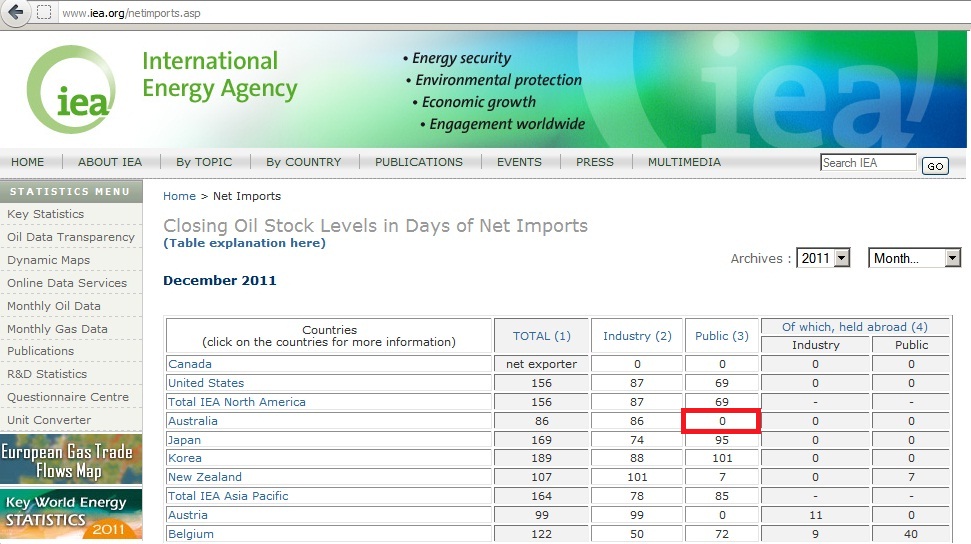 http://www.iea.org/netimports.asp
http://www.iea.org/netimports.asp
But even these 86 days may be embellished. In ACIL Tasman’s so-called oil vulnerability report the consultants try to argue with the IEA by including what the IEA excludes: oil in vessels at sea and the 10% at the bottom of storage tanks. This approach is of course not on the safe side and will one day backfire.
Who will help Australia? It would take months to convert Australian refineries to take local crude which is now being exported. From the AIP website:
Maintaining supply reliability in Australia
“Technical refinery options (depending on duration of the supply disruption):
- Alter the cut points for different products (this option could mean less jet fuel.)
- Change catalysts to produce more/less diesel/petrol (lengthy disruption, very expensive and 3 month implementation time)
- Change crude types together with relaxation of fuel standards (lengthy disruption, 3 month implementation time)”
Up: Just in time supply chain for petroleum from:
http://www.aip.com.au/industry/supplyreliability.htm
The Australian Petroleum Statistics show stocks of petroleum in days of consumption cover:
 Crude oil: 25 days, petrol 17 days, diesel 19 days
Crude oil: 25 days, petrol 17 days, diesel 19 days
http://www.ret.gov.au/resources/fuels/aps/pages/default.aspx
(5) No shortage of oil?
DANIEL YERGIN: ….. . There’s no shortage of oil right now, but I think people will look and say, “Well what about GDP? What about economic recovery?” And as you say, it is an election year.
Comment: Yergin should turn on his TV or look in the internet. There is a shortage of oil that people can afford to buy (see the above mentioned demonstrations in Indonesia against removing subsidies by the government).
On the very day of the interview:
Fuel panic grips Britain, gas lines mount, police called
The Telegraph in UK writes:
“But such “little local difficulties” are as nothing compared to the “upstream” issues that loom. It is on global energy markets, where physical crude is bought and sold in the billions of barrels, that our attention should be focused. The fuel scare we’ve seen in UK villages, towns and cities over the last week is just a microcosm of a worldwide energy struggle.
The underlying reason why oil prices are so firm, as this column has often said, is that global crude demand is rising relentlessly, while the most important oil wells on earth are depleting. Back in 2001, the world consumed 76.6m barrels of oil a day. Last year, just a decade on, global oil use was a hefty 89.1m barrels daily, some 16pc higher.”
(6) Run out of cheap oil
TONY JONES: …… In your book The Quest you conclude that the idea that we’re fast running out of oil has been proven to be wrong, if not completely wrong. What about all these peak oil predictions? Have they been proven wrong as well?
Comment: We have certainly run out of cheap, easy oil since around 2002.
DANIEL YERGIN: Well I think so. I mean, it is something I tackled in The Quest. Clearly people who are worried about peak oil have deep worries what about will happen and so I certainly respect their concerns.
We looked at it, we have the largest databases, our company, IHS CERA, on world oilfields and we just don’t see a peak.
Comment: We can see from past statistics that global crude oil started to peak in 2005. If there is a much higher peak in future – with lower oil prices of course which such an abundance should entail – then Mr. Yergin, show us country-by-country production profiles over at least 30 years – the lifespan of many oil dependent projects. Of course that would cost a lot of money.
Question: Has the Australian government, for example, bought the IHS database and the software to work with these data? How much would that cost in comparison to the billions of dollars spent on highways and airport expansions which are being built without having calculated future oil supplies? If that database is bought with taxpayer’s money would it then not be logical to publish the results in the final version of the Energy White Paper to be released later in the year?
Would the IHS profiles from past production look any different from the ones which can be obtained by using publicly and freely available data like from the EIA or IEA?
Does the graph from this website not show that crude oil production started to peak in 2005? That Russia rescued the world from a deep oil crisis but is also peaking now?
DANIEL YERGIN: So there’s one view that says we’re halfway there out of oil, the others say maybe we’ve used 15 or 20 per cent, and we’ve seen the United States was supposed to be out of the oil business.
Comment: Who said we have used only 15-20 percent (of what exactly?) and who said the US would be out of the oil business? Write it here, with weblinks:
………………………………………………………………………………………………
DANIEL YERGIN: One of the huge oil booms is now actually happening in the United States. New technology is opening up new supply…………..So, the world’s not running out of oil….
Comment: To repeat it for the umpteenth time: peak oil is not about running out of oil. And the huge oil boom can be seen on this graph, in which past production is put together with projections from the US Department of Energy:
Data after 1990 adopted from “Tight oil, Gulf of Mexico deepwater drive projected increases in US crude production”, 8 Feb 2012
http://www.eia.gov/todayinenergy/detail.cfm?id=4910
(7) The myth of US energy sufficiency
TONY JONES: Yes. I mean, you also point out, however, that the United States – and this will surprise many people – is quite close to becoming energy self-sufficient. How did that happen?
Comment: The “Yes” indicates that Yergin’s misinformation has already been accepted and internalised without further double checking statistics.
This graph is from the report “Energy Perspectives 2010″, of the EIA:
 http://www.eia.gov/totalenergy/data/annual/pdf/perspectives_2010.pdf
http://www.eia.gov/totalenergy/data/annual/pdf/perspectives_2010.pdf
So what we see here is that energy imports have indeed gone down, but there are still around 30 Quads of energy imports. So how much is that?
We see petroleum consumption is about 35 Quads. OK, take away 30 quads of that and then the US would be self-sufficient in energy. America, leave your car at home, go on your bikes and take public transport.
DANIEL YERGIN: Four years ago the US was going to be a big importer of liquefied natural gas, including from Australia. Now we’ll probably start exporting some liquefied natural gas. Same thing’s happened with oil.
We are about – you know, the US is about – if you look at all of energy, is about 80 per cent self-sufficient, so the real question is oil. I don’t think we’re going to, any time near here, be independent altogether of supplies. We still import almost half of our oil, but that number’s actually come down. I think we’ll see domestic supplies increase.
Comment: Oil is different from gas. According to the very EIA which declares energy self sufficiency, US net petroleum imports will decrease only marginally:
DANIEL YERGIN: And one of the things I talk about in The Quest is peak demand, which is industrial nations like the United States and others have reached a point where our demand is going to go down, not up because our cars are more efficient, our demographics are changing.
Energy efficiency of cars improving and perhaps aging and shrinking population in the US? Not for the US Department of Energy:
The table clearly shows that fuel consumption for both light and heavy duty vehicles goes up by between 15 and 47%, not down. And the number of drivers increases.
(8) The wrong question on oil reserves and production
TONY JONES: Yes,what’s happened in terms of oil reserves? Is it simply that new techniques or broader exploration or different types of drilling have been employed to open up new unforeseen oil reserves?
Comment: the real question here is whether those “unforeseen oil reserves” and their associated annual oil flows can replace those political oil reserves which don’t exist. This is well documented but always ignored:
 Ex-Saudi Aramco chief Sadad-al-Husseini crossed out 300 GB of OPEC reserves = 30 years OPEC oil supplies, at an Oil & Money conference of Energy Intelligence in London, 2007. We see this problem evolving in slow motion in the Middle East right now in front of our TV eyes. In year X that problem will explode – in fast motion.
Ex-Saudi Aramco chief Sadad-al-Husseini crossed out 300 GB of OPEC reserves = 30 years OPEC oil supplies, at an Oil & Money conference of Energy Intelligence in London, 2007. We see this problem evolving in slow motion in the Middle East right now in front of our TV eyes. In year X that problem will explode – in fast motion.
The above graph from Jean Laherrere illustrates the jump in OPEC reserves in the 80s (quota war, paper barrels). Jean distinguishes political (red curve) and technical reserves (green curve) which are now around 800 Gb.
(9) The Quest for the dirty oil
DANIEL YERGIN: It is exactly what you’ve just described. Technology opens doors that people thought were shut forever. We have a state in the United States called North Dakota. It was a very minor oil producer.
Comment: the shale oil wells yield so little that it doesn’t pay to build pipelines and the oil has to be trucked, 180 barrels at a time. Read here:
27/3/2012
Desperate Times: Trucking shale oil in North Dakota
http://crudeoilpeak.info/desperate-times-trucking-shale-oil-in-north-dakota
DANIEL YERGIN: And suddenly the whole perspective of the United States about energy – even the president in his State of the Union address was expressing pride that US oil production is going up…..
Comment: And it will go down, too
Excerpt from the IEA WEO 2011: “So does light tight oil represent a new energy revolution? It is certainly having an impact in the US, where we estimate production could exceed 1.4 mb/d by 2020, somewhat reducing US imports; but this alone is unlikely to affect the dynamics of global oil supply significantly. For this new source of oil to have a wider impact, production would need to take off in other plays or in other parts of the world.
DANIEL YERGIN: and then what’s happening in Canada with what’s called the oil sands or some call them the tar sands, these were considered a fringe resource even a decade or decade and a half ago. Their output has tripled and just the oil sands alone, the output is greater than all of Libya’s oil production before the civil war.
That’s how it looks like, from: “To the last drop”
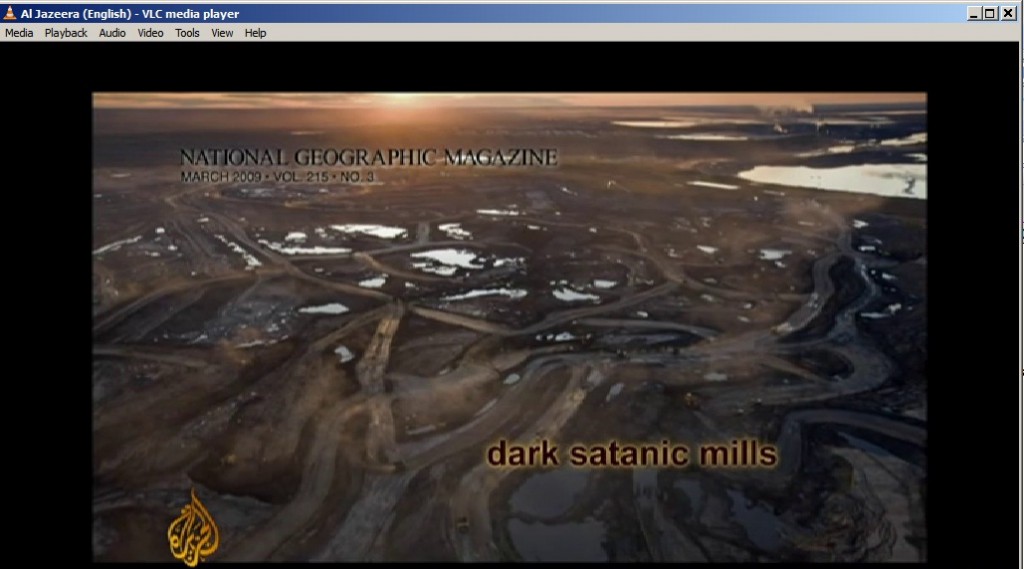 http://www.aljazeera.com/programmes/witness/2011/06/20116227153978324.html
http://www.aljazeera.com/programmes/witness/2011/06/20116227153978324.html
DANIEL YERGIN: So what we’re seeing is the technology bringing new supplies on.
Comment: From the Oil Crunch story:
PROF. ALEKLETT: “Of course you have tar sands. Again, we have done a so-called crash management analysis of the tar sand production in the future. And there are tar sands on the surface that you can get out from pit mines but the biggest fraction is so deep you need to boil water and inject steam into the ground to soften it up and get it out from ground. To do that in the future you need to build nuclear power plants just to boil water and inject it into the ground”
CATALYST: “So it’s not going to save us..”
PROF. ALEKLETT: “No, no, no. It might save Canada…..the best thing to do is to reduce our consumption…from now until 2050 there will be another 2.5 bn people on the planet, and we all need food. We are just close to the limit, when it comes to energy, that we can use to produce food. That’s the main problem for the future that we need to rethink when it comes to food production”
http://www.abc.net.au/catalyst/oilcrunch/
http://www.youtube.com/watch?v=vPnhLuuBnFk
Back to the Yergin interview:
TONY JONES: Yes, Daniel, what you’re telling us really is that fossil fuels are here to stay for many decades at least and that is something of a two-edged sword, isn’t it?
Comment: Many decades? Has Tony forgotten his December 2009 interview with James Hansen?
 TONY JONES: Now you’re accusing governments of lying through their teeth even as they sign up to large emission reduction targets for Copenhagen. Why so pessimistic?
TONY JONES: Now you’re accusing governments of lying through their teeth even as they sign up to large emission reduction targets for Copenhagen. Why so pessimistic?
JAMES HANSEN, CLIMATE SCIENTIST, NASA: ……And if you look at how much carbon there is in oil, gas and coal, what you quickly realise is that oil and gas is already going to be enough to get us up to approximately the dangerous level. The only way we can solve the problem is by phasing out coal emissions and prohibiting unconventional fossil fuels like tar sands and oil shale.
But in fact, if you look at what’s happening, the United States just signed an agreement with Canada to make a pipeline to carry oil from tar sands to the United States, and Australia is expanding its port facilities to export more coal.
http://www.abc.net.au/lateline/content/2008/s2764523.htm
 Only a couple of months after this interview Hansen was in Sydney and gave this lecture at the University of Sydney with his assessment of the future of Australian coal:
Only a couple of months after this interview Hansen was in Sydney and gave this lecture at the University of Sydney with his assessment of the future of Australian coal:
8/3/2010
NASA climatologist James Hansen at Sydney Uni: “Australia doesn’t agree now that they got to stop their coal, but they are going to agree. I can guarantee you that within a decade or so because the climate change will become so strongly apparent that’s going to become imperative”
A 20 sec extract
http://www.youtube.com/watch?v=qMD2sd0lPeg
The full 1 hr 44 min lecture including Q&A is here:
http://www.usyd.edu.au/sydney_ideas/lectures/2010/professor_james_hansen.shtml
or directly on youtube:
http://www.youtube.com/watch?v=5E5EdbiB4HU
Continuing with the Yergin interview:
TONY JONES: So you don’t feel – as someone who’s focused so much of your energy and your life on examining oil, you don’t feel any kind of ambivalence at all about the idea of climate change and it being driven by fossil fuel?
DANIEL YERGIN: Well, I do. I was just listening to the segment just before mine [“ IPCC urges governments to plan for disasters”] and last night I was looking at the segment in the book on exactly that subject, on extreme weather.
Comment: Again, from Hansen:
The above graph is from the Hansen paper:
Perceptions of Climate Change, The New Climate Dice
5/1/2012
“Climate dice”, describing the chance of unusually warm or cool seasons relative to climatology, have become progressively “loaded” in the past 30 years, coincident with rapid global warming. The distribution of seasonal mean temperature anomalies has shifted toward higher temperatures and the range of anomalies has increased. An important change is the emergence of a category of summertime extremely hot outliers, more than three standard deviations (σ) warmer than climatology. This hot extreme, which covered much less than 1% of Earth’s surface in the period of climatology, now typically covers about 10% of the land area. We conclude that extreme heat waves, such as that in Texas and Oklahoma in 2011 and Moscow in 2010, were “caused” by global warming, because their likelihood was negligible prior to the recent rapid global warming. We discuss practical implications of this substantial, growing climate change
….
The increase, by more than a factor 10, of area covered by extreme hot anomalies (> +3σ ) in summer reflects the shift of the anomaly distribution in the past 30 years of global warming, as shown succinctly in Fig. 4. One implication of this shift is that the extreme summer climate anomalies in Texas in 2011, in Moscow in 2010, and in France in 2003 almost certainly would not have occurred in the absence of global warming with its resulting shift of the anomaly distribution. In other words, we can say with a high degree of confidence that these extreme anomalies were a consequence of global warming..
….
The other extreme of the hydrologic cycle, unusually heavy rainfall and floods, is also expected to be amplified by global warming. The amount of water vapor that the atmosphere holds increases rapidly with atmospheric temperature, and thus a warmer world is expected to have more rainfall occurring in more extreme events. What were “100-year” or “500-year” events are expected to occur more frequently with increased global warming. Rainfall data reveal significant increases of heavy precipitation over much of Northern Hemisphere land and in the tropics (3) and attribution studies link this intensification of rainfall and floods to human-made global warming.
http://www.columbia.edu/~jeh1/mailings/2012/20120105_PerceptionsAndDice.pdf
TONY JONES: …..but they [the Chinese] – somewhere or other they need this transformative technology so finally if the great powers ever decided that global warming really did pose an existential threat not only to their own national security, but also to global security, to the world, would they be capable of mobilising something like a global Manhattan Project to come up with a new clean-energy source?
DANIEL YERGIN: Well, I think a Manhattan Project, which gave us the atomic bomb, was really aimed at producing two bombs; economics didn’t matter. Here you’re talking about changing markets.
Comment: That Manhattan project is definitely not to go for unconventional fossil fuels as promoted by Yergin at the beginning of the interview. So what Yergin proposes in Quest is contradictory and we are turning in circles here.
Conclusion:
This ABC TV interview with Yergin is a step backwards. It seems our journos do not learn but recycle opinions in an endless debating club competition which is going no-where.



